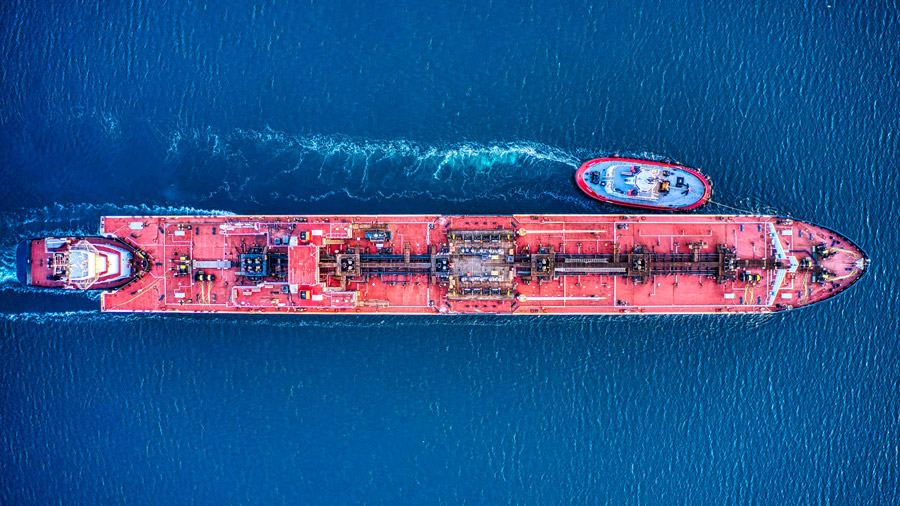
Navigating the uncharted waters of IMO 2020: Fuel stability and compatibility challenges
By Dr. Raj Shah, Dr. Sal Rand, and Jacky Jiang
The International Maritime Organization (IMO) has announced a changing of the tides, steering 2020 in a new direction, by implementing a regulation that limits the sulphur content of marine fuels from 3.5% to 0.5%, starting 1st January 2020. The only exemption from this industry-wide ban includes fuels burned in Sulphur Emission Control Area or Emission Control Area (SECA or ECA) regions.
There are two basic types of marine fuels — distillate and residual. Distillate fuel, also known as Marine Gas Oil (MGO), is composed of petroleum fractions that are separated from crude oil in a refinery with a distillation process. Residual fuel, or heavy fuel oil (HFO) which are much cheaper than MGO, consists of process residues and has an asphaltene content of between 3% and 10%. The need to switch to and from one of these fuel variants when entering or leaving an ECA poses a range of issues for vessel operators — many of which are still not fully understood by the wider industry.
HFOs are permitted on ships that have exhaust gas cleaning systems known as scrubbers, which removes sulphur oxides and lowers sulphur emissions. The total global demand for fuel oil is roughly seven million barrels per day, with the marine industry responsible for half of residual fuel oil demand. Therefore, this new regulation is having a drastic effect on the availability and the cost of marine fuels.
 An issue of contention arising from this new regulation concerns the compatibility and stability of sulphur-compliant fuels. According to the ISO specification of marine fuels (ISO 8217), fuels are required to have a “homogeneous blend of hydrocarbons derived from petroleum refining,” which is an indication of stability. The stability of a residual fuel is associated with the ability of the asphaltenes to remain in a suspended state. In other words, stability depends on the nature of the hydrocarbons in the fuel. Ideally, bunker residual fuels should be segregated to prevent the agglomeration of the asphaltene contents. During the blending of fuel oils, the uniform dispersion of asphaltenes in the residual fuel can be thrown out of equilibrium, resulting in an unstable dispersion of asphaltenes.
An issue of contention arising from this new regulation concerns the compatibility and stability of sulphur-compliant fuels. According to the ISO specification of marine fuels (ISO 8217), fuels are required to have a “homogeneous blend of hydrocarbons derived from petroleum refining,” which is an indication of stability. The stability of a residual fuel is associated with the ability of the asphaltenes to remain in a suspended state. In other words, stability depends on the nature of the hydrocarbons in the fuel. Ideally, bunker residual fuels should be segregated to prevent the agglomeration of the asphaltene contents. During the blending of fuel oils, the uniform dispersion of asphaltenes in the residual fuel can be thrown out of equilibrium, resulting in an unstable dispersion of asphaltenes.
Asphaltene separation, colloquially known as sludge, can be deleterious to ship engines and, therefore, should be avoided to ensure optimal performance. However, during the storage of various fuel oils in bunkers, it is not always feasible to separate the fuels and, consequently, commingling can occur. New fuel formulations are also being made using different fuels with varying sulphur content to adhere to the new sulphur specification. This means the compatibility of commingled fuels is a requirement, making familiarity with these new sulphur-compliant fuels a necessity.
In addition to the global sulphur cap of 2020, a notable amendment to the regulation is the entry into force of a rule to ban the carriage of non-compliant fuel oil effective 1 March 2020. The complementary International Convention for the Prevention of Pollution from ships (MARPOL) amendment prohibits the carriage of non-compliant fuel oil for combustion purposes for propulsion or operation on board a ship — unless the ship has an approved scrubber.
While there will still be an allowance to carry HSFO on cargo, it will not be permitted to have HSFO carried in fuel tanks, unless scrubbers are in use. This is for the purpose of enabling port state control to detain ships carrying non-compliant fuel, without having to figure out if it has been used or not. This is to discourage non-compliance when traversing through international waters. There are some ports which have prescribed the use of open-loop scrubbers within their domain.
Open loop scrubbers use seawater to lower the sulphur content of the exhaust gases to an equivalent of 0.10%. The process water is discharged overboard in compliance with IMO 2020 regulations. Open loop systems are primarily used for vessels that operate mainly in the open sea.
The European Union Sulphur Directive designates a maximum of 0.10% sulphur content for ships in EU ports. In certain EU countries, the Water Framework Directive constricts the discharge of scrubber water. In Germany, as well as in Belgium, the discharge of scrubber water in many areas is now verboten, thus preventing the operation of open loop scrubbers. In addition, other EU countries may follow their lead; however, no overarching EU practice is likely to be agreed upon.
 As of 1st January 2019, China announced that it was expanding the geographical coverage of its 0.50% sulphur area to a 12-nautical mile zone, spanning the entirety of the Chinese coastline, including the special administrative regions of Hong Kong and Macao, and Taiwan. Moreover, discharging wastewater from scrubbers is outlawed within inland ECAs, port waters and the Bohai Bay waters. A total embargo on open-loop scrubbers from the country’s ECA may also be enacted at a later date.
As of 1st January 2019, China announced that it was expanding the geographical coverage of its 0.50% sulphur area to a 12-nautical mile zone, spanning the entirety of the Chinese coastline, including the special administrative regions of Hong Kong and Macao, and Taiwan. Moreover, discharging wastewater from scrubbers is outlawed within inland ECAs, port waters and the Bohai Bay waters. A total embargo on open-loop scrubbers from the country’s ECA may also be enacted at a later date.
The California Air Resources Board (CARB) invokes a 0.10% sulphur limit within 24 nautical miles of California’s coast. The regulation forbids any other compliance options besides low-sulphur marine gas or diesel oil (DMA or DMB). A transitory research exemption may be given, allowing the use of a scrubber. The application must be submitted before entering California waters. Following a formal review of the regulation, California legislators have made the decision to sustain it as an addition to the ECA requirements. It is compulsory that ships comply with both sets of regulations when calling on a California port.
A widespread global trend is in effect enacting more stringent local air pollution regulations. This is further elucidated by emissions regulations, both already in effect and pending, in areas such as the Panama Canal, Taipei and local municipalities around the globe.
A study was recently conducted by Concawe, which consists of oil and gas companies that operate in Europe to carry out research on environmental issues relevant to the oil industry, to evaluate the effectiveness of several ASTM test methods in predicting the stability and compatibility of sulphur-compliant marine fuels. These test methods include: ASTM D4740, Standard Test Method for Cleanliness and Compatibility of Residual Fuels by Spot Test; ASTM D7157, Standard Test Method for Determination of Intrinsic Stability of Asphaltene-Containing Residues, Heavy Fuel Oils, and Crude Oils (n-Heptane Phase Separation; Optical Detection); ASTM D7112, Standard Test Method for Determining Stability and Compatibility of Heavy Fuel Oils and Crude Oils by Heavy Fuel Oil Stability Analyzer (Optical Detection); and, ASTM D7060, Standard Test Method for Determination of the Maximum Flocculation Ratio and Peptizing Power in Residual and Heavy Fuel Oils (Optical Detection Method).
 The fuels used for this study were: ultra-low sulphur fuel oil (ULSFO), very low sulphur fuel oil (VLSFO), low-sulphur fuel oil (LSFO) and HSFO. By testing the stability of a fuel sample mixture, an indication can be obtained regarding the potential compatibility between the two fuels used in the mixture at a specific ratio. Although, even if two individual residual fuels are found to be stable, the compatibility of the pair of fuels is still inconclusive. Table 1 shows a detailed distribution of the samples and the associated fuel category.
The fuels used for this study were: ultra-low sulphur fuel oil (ULSFO), very low sulphur fuel oil (VLSFO), low-sulphur fuel oil (LSFO) and HSFO. By testing the stability of a fuel sample mixture, an indication can be obtained regarding the potential compatibility between the two fuels used in the mixture at a specific ratio. Although, even if two individual residual fuels are found to be stable, the compatibility of the pair of fuels is still inconclusive. Table 1 shows a detailed distribution of the samples and the associated fuel category.
The overall comparison of the performance of ASTM D7157, D7112, and D7060 with ISO 10307-2 (Total sediment in residual fuel oils — Part 2: Determination using standard procedures for ageing) is shown in Table 2. This part of ISO 10307 specifies two procedures — A (thermal) and B (chemical) — for the accelerated ageing of residual fuel oils. When combined with the hot filtration method specified in ISO 10307-1, these procedures permit the prediction of fuel oil stability, as affected by sedimentation, during storage and handling of fuel oils.
The green-shaded areas, orange-shaded areas, and red-shaded areas represent “good”, “poor”, and “bad” predictions, respectively. These predictions are used as an indication of the quality and accuracy of the prediction methodology.
For ASTM D7157 and D7112, predictions agree with TSP evaluation when SBNmix› 1.4INmax. However, when the predictions are in the critical or unstable area, verification with Total Sediment Potential (TSP) is recommended. Predictions from ASTM D7060 agree with TSP evaluation when the p-ratio is greater than 1. Incompatible fuels evaluated from ASTM D7060 should be verified with TSP. Inconsistencies have occurred in the comparison, but the three ASTM test methods can still be useful in predicting the possibility of incompatible fuels.
These new regulations are upending the sphere of marine fuels. In an endeavor to swim with this current, the ECA 0.10% sulphur cap has already generated the development of new low-sulphur fuels. However, the IMO decree to initiate a 0.50% global sulphur cap in 2020 may result in added difficulties regarding engine operation.
The industry has turned to Liquified Natural Gas (LNG) as a potential aid in meeting these new regulations, since LNG can reduce sulphur oxide (SOx) emissions by approximately 90% when compared with HFO. This stark contrast renders LNG an appealing option from a compliance point of view. At first, there were complicating factors at play such as the fact that operators would need to fully weigh the viability of their vessels to carry LNG and ascertain whether they are able to access an available, dependable and economical supply chain. With recent investments, vessels are now able to overcome these factors.
 Consequently, marine fuels industry professionals and observers are prognosticating a multi-fuel strategy, with LNG augmenting in the future, as opposed to completely supplanting the current fuels of today. What the precise degree of take-up will be remains, at present, unknown as owners and operators assiduously grapple with the possibilities being presented to them for their fleets. There is no “one-size fits all” answer to this challenge. Some factors which will help solidify compliance decisions will need to be considered on an individual basis, include trading routes and age of vessels.
Consequently, marine fuels industry professionals and observers are prognosticating a multi-fuel strategy, with LNG augmenting in the future, as opposed to completely supplanting the current fuels of today. What the precise degree of take-up will be remains, at present, unknown as owners and operators assiduously grapple with the possibilities being presented to them for their fleets. There is no “one-size fits all” answer to this challenge. Some factors which will help solidify compliance decisions will need to be considered on an individual basis, include trading routes and age of vessels.
The mega marine engines of ships burn tons of fuel daily. This is necessary to propel these heavily loaded ships. Low-grade fuel oils are typically employed in these gargantuan engines to mitigate the ship’s huge operating expenditures of fuel which can potentially be upwards of 60-70% of the ship’s total operating costs.
New LSFO blends can be mainly aromatic or mainly paraffinic in their compositions, depending on how they are blended and refined. Consequently, due to these disparities, issues of compatibility can arise between different batches when mixed on ships, a process known as commingling. Commingling bunker fuels from divergent origins could produce sludge formations, which can damage engines.
When two incompatible fuels are mixed, another potential issue can occur, asphaltene separation. This is when asphaltenes precipitate and subsequently form sludge on the inside of engine filters and separators. This is undesirable because it can cause a ship to lose its propulsion and auxiliary power. Fuel testing agencies will be gearing up to test compatibility from suppliers at various locations.
Shipowners already have a variety of potential solutions at hand to curb the risk of incompatibility and resultant engine failure. For instance, most buyers will continue using LSFO mixtures which hail from different supplies in their own separate tanks. This is a safety practice which is already widely used when bunkering HSFO blends. The International Bunker Industry Association (IBIA) has admonished shipowners to stave off commingling by segregating tanks to maintain a variety of fuel qualities, adding complexity to a ship’s operation.
Some shipowners, in the interest of foresight, have gotten a head start in preparation for 2020, by already segregating their fuel tanks. Shipowners who possess scrubbers on their vessels will see that their storage tank ratio of LSFO to MGO will most likely continue unchanged into 2020.
At the other end of the spectrum, a subset of shipowners prefer to keep the status quo, maintaining business as usual as they deliberate on how to proceed. Their options include the following: a) convert to 0.5% LSFO, b) install a scrubber or switch to LNG. This waffling has been due in part to a pall of uncertainty surrounding fuel prices, fuel supply and scrubber availability. Shippers have also been eyeing the IMO to glean how strictly the UN agency would enforce the IMO 2020 regulation.
A proposal by various flag states that an experience building phase (EBP) be added to the regulations was defeated at MEPC 73, while recent amendments to Marpol Annex VI will forbid non-scrubbing vessels from carrying more than 0.5% fuel oil on board as of 1st March 2020.
The IMO is ostensibly staunch in its avowal to demand strict compliance to the reduced sulphur cap. Although, as a special agency of the United Nations, the IMO has no real authority to enforce the new regulations itself. Adherence may, ultimately, be market driven. Global customer-facing monoliths such as Walmart and Ikea have a built-in brand-protective interest in demanding that shipping firms comply with the new rules to curtail bad publicity from environmental groups and an ecologically minded public. Failure to comply with the global sulphur cap could also cause a vessel to be deemed “unseaworthy” for insurance purposes.
In practice, the 0.5% global cap will be enforced worldwide by Port State Control (PSC) authorities. At the beginning of April, the Maritime and Port Authority of Singapore, which has already banned open loop scrubbers, stated that, from the beginning of 2020, captains and owners of vessels which burn high sulphur fuel within its territorial waters, without utilizing sulphur-reducing technology such as scrubbers, could be sentenced to up to two years in prison.
This is contrary to other flag states outside North America and northwest Europe, which are often low on resources, as well as lacking in commitment to doling out serious penalties. Worldwide, only a small portion of port states have experience in this field. The global average sulphur content of HSFO is 2.7%, which is lower than the current IMO emissions cap of 3.5%. Because of this, compliance has not been on the radar of much of the seafaring world. Prior to 2020, 91 states ratified MARPOL Annex VI. All are required to sanction IMO 2020. Even with that being the case, only 31 already had sulphur regulations in effect with only a paltry 16 being ECA regions. This illustrates a sweeping dearth of experience in administering sulphur regulation compliance. ECA countries are only used to monitoring their own waters and not the vast open sea. This is the impetus buttressing the new legislation banning all vessels without scrubbers from transporting HSFO starting March 1.
It is recommended that buyers who intend to commingle the new fuels should conduct compatibility tests to start with. The preferred method for achieving this is the ASTM D4740 spot test. This is a tool of analysis to scope out possible commingling conflicts between grades. Shipowners can also choose to make use of any of the several fuel additives available to reduce sludge formation.
As with any new changes, there are sure to be some growing pains and learning curves, especially concerning incompatibility between new LSFO and distillate blends. However, with the proper tools and knowledge, shipowners should not commingle them with any more regularity than they did HSFO blends in prior years. Once these new regulations are acclimated to, vessels should continue to enjoy smooth sailing into 2020 and beyond.








